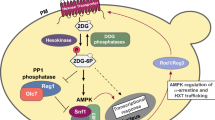Summary
Long before the mechanism of fermentation was understood,Pasteur discovered an important regulatory phenomenon of carbohydrate metabolism. He observed that yeast consumes more sugar anaerobically than aerobically. This so-called Pasteur effect has been subject of many controversies and an analysis of the development of the concepts has been presented. Among the key errors made in the early evaluations was to emphasize the control of end product formation rather than of hexose utilization.
The Pasteur phenomenon as understood at present is a complex coordinated control mechanism which operates at several levels. The basic phenomenon is a competition between glycolysis and oxidative phosphorylation for the available ADP and inorganic phosphate. Superimposed are allosteric controls of hexokinase (glucose-6-phosphate) and of phosphofructokinase (ATP). However, in some cells glucose-6-phosphate is not an inhibitor of hexokinase and ATP levels do not change significantly during transition from aerobic to anaerobic conditions. It is therefore clear that other secondary allosteric effectors such as inorganic phosphate play a significant role. The major conclusion is that there are multiple and different control mechanisms participating in the Pasteur effect in different cells.
A loss of control in tumor cells gives rise to a high aerobic glycolysis. The history and possible significance of this in malignancy is described.
Similar content being viewed by others
References
L. Pasteur, C. R. Acad. Sci. 52, 1260–1264 (1861).
O. Warburg, Biochem. Z. 172, 432–441 (1926).
D. Burk, Cold Spring Harb. Symp. quant. Biol. 7, 420–459 (1939).
H. A. Krebs, in Essays in Biochemistry (P. N. Campbell and F. Dickens, eds.) Academic Press. Vol. 8, p. 1–34 (1972).
J. Fruton, “Molecules and Life”, John Wiley & Sons, Inc. New York (1972).
F. Kützing, J. Prakt. Chem. 11, 385–409 (1837).
L. Pasteur, Comp. Rend. 45, 913–916 (1857).
F. Lynen, Justus Liebigs Ann. Chem. 546, 120–141 (1941).
M. Johnson, Science, 94, 200–202 (1941).
R. Wu and E. Racker, J. Biol. Chem. 234, 1029–1035 (1959).
B. Chance, in Ciba Foundation Symposium on the Regulation of Cell Metabolism (G. E. W. Wolstenholme and C. M. O'Conner, eds.), J. & A. Churchill, London, pp. 91–121 (1959).
J. B. Alpers, R. Wu and E. Racker, J. Biol. Chem. 238, 2274–2280 (1963).
E. C. Dodds and G. D. Greville, Lancet I, 398–399 (1934).
W. F. Loomis and F. Lipmann, J. Biol. Chem. 173, 807–808 (1948).
S. Gatt and E. Racker, J. Biol. Chem. 234, 1024–1028 (1959).
E. Racker in Advances in Enzymology (F. F. Nord, ed.), Interscience Publishers, New York, Vol. XV, pp. 141–182 (1954).
F. Lynen and R. Königsberger, Justus Liebigs Ann. Chem. 573, 60 (1951).
V. A. Engelhardt and N. E. Sakov, Biokhimiya, 8, 9–36 (1943).
F. Lynen, G. Hartmann, K. F. Netter and A. Schuegraf, in Ciba Foundation Symposium on the Regulation of Cell Metabolism (G. E. W. Wolstenholme and C. M. O'Conner, eds.) J. & A. Churchill, London, pp. 256–237 (1959).
K. K. Lonberg-Holm, Biochim. Biophys. Acta, 35, 464–472 (1959).
H. A. Lardy and R. E. Parks, Jr., in Enzymes: Units of Biological Structure and Function (O. H. Gaebler, ed.), Academic Press, New York, p. 584 (1956).
K. Uyeda and E. Racker, J. Biol. Chem. 240, 4689–4693 (1965).
J. R. Williams, B. A. Herczeg, H. S. Coles and W. Y. Cheung, J. Biol. Chem. 242, 5119–5124 (1967).
E. Racker, “Mechanisms in Bioenergetics”, Academic Press, Inc., New York (1965).
J. V. Passonneau and O. H. Lowry, Biochim. Biophys. Res. Commun. 7, 10–15 (1962).
K. Uyeda and E. Racker, J. Biol. Chem. 240, 4682–4688 (1965).
I. A. Rose, J. V. B. Warms and O'Connel, E. L., Biochem. Biophys. Res. Commun. 15, 33 (1964).
J. Krzanowski and F. M. Matschinsky, Biochem. Biophys. Res. Commun. 34, 816–823 (1969).
P. J. Randle, R. M. Denton and P. J. England, in The Metabolic Roles of Citrate (T. W. Goodwin, ed.) Biochemical Society Symposium, 27, pp. 87–103 (1968).
Z. Dische, Bull. Soc. Chim. Biol. 23, 1140–1148 (1941).
S. Rapoport, personal communication.
R. Wu and E. Racker, J. Biol. Chem. 234, 1036–1041 (1959).
E. B. Goldberg, H. M. Nitowsky and S. P. Colowick, J. Biol. Chem. 240, 2791 (1965).
K. Tornheim and J. M. Lowenstein, J. Biol. Chem., 248, 2670–2677 (1973).
G. Acs, T. Garzo, G. Grosz, J. Molnar, O. Stephaneck, and F. B. Straub, Acta Physiol. Acad. Sci., Hung. 8, 269 (1955).
I. A. Rose and J. V. B. Warms, J. Biol. Chem. 242, 1635–1645 (1967).
H. R. Knull, W. J. Taylor and W. W. Wells, J. Biol. Chem. 248, 5414–5418 (1973).
O. Warburg, Über den Stoffwechsel der Tumoren, Springer Verlag, Berlin (1926).
C. F. Cori and G. T. Cori, J. Biol. Chem. 65, 397 (1925).
C. E. Wenner, in Advances in Enzymology (F. F. Nord, ed.), Interscience Publishers, New York, Vol. 29, pp. 321–390 (1967).
E. Racker, American Scientist, 60, 56–63 (1972).
S. Weinhouse, Science, 124, 267 (1956).
E. Racker, R. Wu and J. B. Alpers, in Amino Acids, Proteins and Cancer Biochemistry (J. T. Edsall, ed.) Academic Press, New York, pp. 175–189 (1960).
P. Scholnick, D. Lang and E. Racker, J. Biol. Chem. 248, 5175–5182 (1973).
P. Mitchell, Biol. Rev. (Cambridge) 41, 445 (1966).
E. Racker, Biochim. Biophys. Acta, in press (1973).
E. P. Wigner, Proc. Am. Phil. Soc. 133, 95–101 (1969).
M. Polanyi, Science, 160, 1308–1312 (1968).
Author information
Authors and Affiliations
Rights and permissions
About this article
Cite this article
Racker, E. History of the Pasteur effect and its pathobiology. Mol Cell Biochem 5, 17–23 (1974). https://doi.org/10.1007/BF01874168
Issue Date:
DOI: https://doi.org/10.1007/BF01874168



